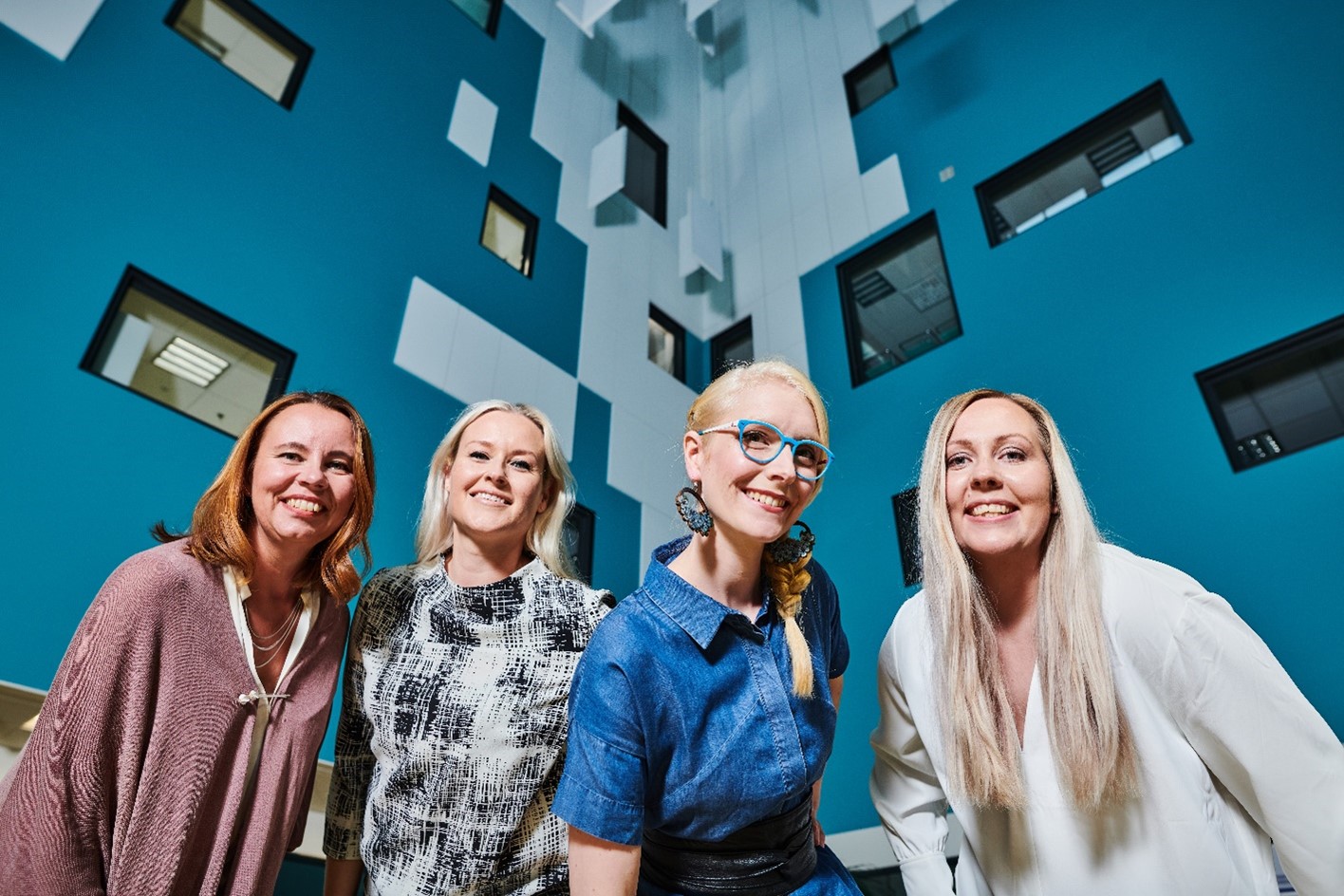Pictured from left to right: Heli Skottman, Tanja Ilmarinen, Laura Koivusalo and Anni Mörö.
Written: Promise Emeh
Photo credit: StemSight
Artikkeli suomeksi
StemSight – curing blindness with stem cells
Corneal transplants are the most common tissue transplants apart from blood transfusion. However, there are about 70 times more patients waiting for a transplant than donors. StemSight seeks to cure corneal blindness by making off-the-shelf grafts from human induced pluripotent stem cells (hiPSCs). HiPSCs are skin or blood cells that have been reprogrammed into an embryonic-like pluripotent state, serving as an unlimited source for the development of any type of human cells needed.
“The cornea is complex, so we are approaching it one cell type at a time” Koivusalo explains. Currently StemSight owns intellectual properties for two types of cornea cells: limbal stem cells – which regenerate the corneal surface epithelium, and the corneal endothelial cells – which make up the inner lining of the cornea.

The transition from academia to business
Laura Koivusalo graduated as a Doctor of Science from Heli Skottman’s group at Tampere university where she developed biomaterial carriers for delivering cells to the cornea. During that time, she worked with the limbal stem cells as a side project. She did her Master’s in Tampere University of Technology in material science, tissue engineering and Bachelor’s in health biosciences at Turku University.
Even though Koivusalo enjoyed her time as an academic researcher, she had always wanted to get into business to see the results of science go to patients and get into actual use. She ended up doing a PhD because she was at the time looking for a permanent job and came across the position in Skottman’s group. It was perfect timing, and the project was really interesting. It was during her PhD that she got involved in the project that later spun off into StemSight

The deeper you dive, the faster you learn to swim
“I never thought I would be the CEO of a company”, Koivusalo says smiling. Laura started out going to pitching competitions, looking for someone with business skills to join the StemSight founding team of researchers. It was at one of such competitions that one of the judges told her “You’re doing great, and the idea is great, but you don’t need anyone else to do it. Any one of you can be the CEO.” This was a light bulb moment for the team and Laura ended up as CEO!
Pitching requires a lot of work in formulating the concept of your company, business strategies, the product and the target consumers. Going to pitching competitions early on helped StemSight get good feedback and work better on their products and strategy. It also helped them think of ways to present complex biological issues in an understandable way. The better you understand science, the easier it is to pack it into an understandable form: making the complex simpler.
“Anyone starting a business should join early mentoring/incubator programs that give you opportunities to talk about your ideas and get feedback”, Koivusalo advises. “You need to start talking about your ideas quite early otherwise you end up building a product nobody wants, understands or needs. So yes, go in early and the deeper you dive, the faster you learn to swim.”
Busy business
Timeline appears very different between business and academia. In a company, many things are tried and those that don’t work are discarded more quickly as opposed to academia. The focus in academia is quite different. “In our company, more important goals are prioritized, because at the moment we have a rather small team” Laura emphasizes.
The bridge
Regarding the differences between academia research and sales/marketing, Koivusalo explains how to bridge the gap between academia and business when it comes to motivation and profit. Approaching both in a purpose driven way is the bridge. Be it in academia or business, you must have a purpose that drives you.
“If your purpose is good and you’re putting in the work to achieve it, then the profits will follow. It wouldn’t make sense to go in just for the profits as the risks are quite high in the biotech field; it’s all hypothetical. You need to believe in what you do, to be able to convince others to join you. When you have a lot of dedicated people working for the same goal, then you have better chances of success.”
Is there a balance between purpose and profit? “Of course, you should have some ideas of the potential profits. I researched other similar companies and how much they were sold for and presented that as an estimation when speaking with investors, Koivusalo explains. It is typical in the biotech space that you develop a product and, in the end, it’s so attractive that someone wants to buy your company. So, to the investors the product is the company.”
PhD a necessity?
“I’m a firm believer that a PhD is not mandatory,” Koivusalo emphasizes. “It depends on what you want to do, if you are looking for a position in a big company you might be at a disadvantage without a PhD. You need to find the bigger goal of what you want to achieve in life and see if a PhD is a stepping stone on that path or not. For a PhD, you should be very critical on the topic you choose as it is quite defining of your career either in academia or business.”
Most relevant lesson from academia
“Resilience. From the many failed experiments in research, you learn to take the lessons and move forward. This is similar to an early-stage company, you just must take the hits and bounce back up” Koivusalo expressed with certainty.
Read more on how StemSight works here.

